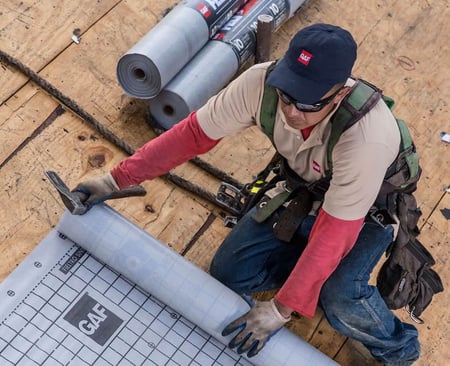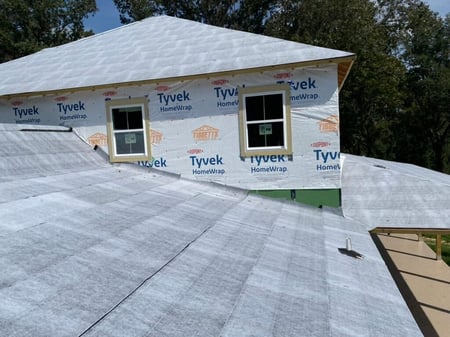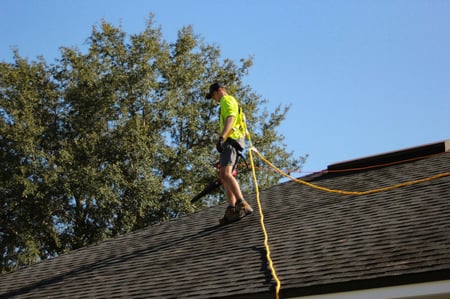All About Underlayment: Types, Installation, & Importance
December , 2023 | 6 min. read
By David Toth

Roofing underlayment stands as a cornerstone in the realm of roofing systems, offering a vital layer of defense against weather elements and potential damage. Understanding the diverse types of underlayment, ranging from traditional asphalt-saturated felt to advanced synthetic materials or self-sealing options opens up a spectrum of choices for homeowners and contractors. Only, how do I choose?
At RoofCrafters, we get it. There are a plethora of underlayment options available, and finding the right one for your roof may seem stressful, but it doesn’t have to be! We also know that the meticulous planning and installation process is a key component to your latest underlayment addition, which is usually the culprit of confusion for many homeowners.
Listen, it’s okay to be confused when it comes to crossword puzzles, or assembling your new wardrobe when the instructions are in Swedish, but it is never okay to be confused about your roof, and that’s why we’re here! Look to RoofCrafters as your trusted mentor, guiding you through the realm of all-things-roofing. That being said, ease some of that confusion by reading ahead to learn about roofing underlayment types, how it is installed, and its importance.
What Is Roofing Underlayment?

Roofing underlayment is a crucial component of a roofing system that's installed directly onto the roof deck before the shingles or other roofing materials are applied. Its primary purpose is to provide an additional layer of protection against water infiltration and other weather-related elements. Roofing underlayment is essential because it acts as a secondary line of defense against leaks caused by wind-driven rain or any water that manages to get underneath the outer roofing material.
It helps to protect the roof deck, prevents moisture buildup, and can provide temporary protection if the outer layer of the roof is damaged in a storm or during construction. There are several types of underlayment available for roofing, each with its own characteristics and suitability for different roofing materials and conditions. Here are the 5 most popular options:
.png?width=1200&height=200&name=Recommended%20Reading%20(57).png)
Asphalt-saturated felt: Commonly known as felt paper or tar paper, this traditional underlayment is made from a base of cellulose, polyester, or bitumen saturated with asphalt. It's cost-effective, offers basic water resistance, and comes in various weights (measured in pounds per square). Typical weights include 15, 30, and 40 pounds.
Synthetic underlayment: Made from polyethylene or polypropylene polymers, synthetic underlayment is more modern and offers enhanced durability, tear resistance, and better protection against moisture compared to traditional felt. It's lightweight, easier to handle, and usually comes in rolls. Synthetic underlayment is often more expensive than felt paper but provides better overall performance.
Rubberized asphalt underlayment: This type of underlayment combines asphalt with rubber polymers to create a highly flexible and self-sealing material. It offers excellent waterproofing and is ideal for areas prone to heavy rainfall or extreme weather conditions.
Peel-and-stick underlayment: Also known as self-adhesive or self-sealing underlayment, this type has an adhesive backing that sticks directly to the roof deck, creating a watertight seal around fasteners and penetrations. It's easy to install and provides superior protection against leaks.
Vapor barrier underlayment: Designed to prevent moisture from penetrating the roof deck, vapor barrier underlayment is particularly useful in areas with high humidity levels. It helps control condensation and moisture buildup within the roofing system.
Each type of underlayment has its own advantages and is suitable for different roofing materials and environmental conditions. Consider factors such as cost, durability, weather resistance, and local building codes when choosing the right underlayment for your roof. Consulting with your local roofing professional can help you determine the most suitable option for your specific needs.
How Is Roofing Underlayment Installed?

Installing roofing underlayment typically involves these general steps:
Prepare the roof deck: Your roofer will ensure that the roof deck is clean, dry, and free from any debris. They’ll repair any damaged areas or protrusions that could affect the underlayment's ability to lay flat.
Start at the bottom: Your roofer will begin by installing the underlayment at the lowest edge of the roof, typically the eaves or lowest point. They’ll then secure the first row horizontally along the edge, leaving a slight overhang if required by the manufacturer's instructions.
Overlap rows: The roofer will then install subsequent rows of underlayment, ensuring an overlap according to the product's specifications. The amount of overlap varies depending on the type of underlayment and local building codes, but a common overlap is around 2 to 6 inches.
Secure the underlayment: They’ll use fasteners appropriate for the underlayment type and roofing material. Staples, nails, or special cap nails may be used to secure the underlayment to the roof deck. Fasteners should be placed at recommended intervals along the edges and field of the underlayment.
Address penetrations and edges: Your roofer will pay special attention to areas around vents, chimneys, and other penetrations, and properly cut and seal the underlayment around these areas to ensure a watertight seal. Additionally, they may install metal drip edges or flashing to protect vulnerable edges.
Work upwards: Your roofer will continue installing the underlayment row by row, working their way up the roof while ensuring each row overlaps correctly and any seams are properly sealed.
Finish the top: Once the underlayment is installed across the roof, your roofer will secure the final row at the top. They’ll trim excess underlayment as needed and ensure proper sealing around ridge vents or other upper roof elements.
Why is Underlayment Important?

Roofing underlayment plays a vital role in the overall protection and longevity of a roofing system. Here are 5 reasons why it's crucial:
.png?width=1200&height=200&name=Recommended%20Reading%20(56).png)
Water resistance: Underlayment serves as a barrier against water infiltration. Even if the outer layer of the roof, like shingles or tiles, is damaged or doesn't provide a perfect seal, the underlayment acts as an additional defense against water entering the structure.
Protection from moisture: It helps prevent moisture buildup and condensation within the roofing structure, which could lead to rot, mold, and other forms of damage to the roof deck and the interior of the building.
Enhanced durability: Underlayment provides an extra layer of protection against physical damage during installation or severe weather conditions like heavy winds, hail, or debris impact. This helps extend the lifespan of the roof.
Temperature regulation: Some types of underlayment also offer insulation properties that can help regulate temperature and reduce energy costs by minimizing heat transfer through the roof.
Temporary protection: During roof installation or repairs, underlayment can provide temporary protection against the elements until the final roofing material is installed, preventing interior damage from rain or snow.
Understanding Underlayment
As you now know, roofing underlayment, available in various types like asphalt-saturated felt, synthetic materials, rubberized asphalt, and more, stands as a crucial safeguard in the realm of roofing systems. Understanding the diverse types and their unique characteristics, such as enhanced durability, superior moisture resistance, or self-sealing properties, empowers homeowners and contractors to choose the ideal underlayment for specific roofing materials and environmental conditions.
The installation process, starting from meticulous preparation of the roof deck to overlapping rows, sealing penetrations, and ensuring proper fastening, underscores the importance of a well-executed underlayment application. This doesn't only merely fortify against water infiltration but also safeguards against physical damage and temperature fluctuations, ultimately bolstering the structural integrity of the entire building.
Recognizing the pivotal role underlayment plays in shielding against weather elements, controlling moisture, and extending the lifespan of roofing systems highlights its significance in ensuring long-term resilience. Selecting the appropriate type and methodically installing underlayment remains an essential step in fortifying roofs, ensuring enduring protection, and maintaining the integrity of structures against diverse environmental challenges. If you’re due for a roof replacement, be sure to hit the “Schedule an Inspection” button down below, and one of our experts will walk you through your underlayment options!
My name is David Toth and I am the lead estimator in North Florida with RoofCrafters Roofing. Originally from New Brunswick, I have called Florida home for the past 47 years. I enjoy cooking along with traveling to different historical areas in Florida when I have free time.



